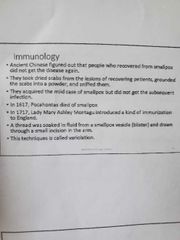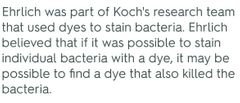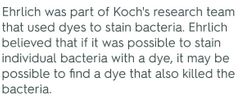![]()
![]()
![]()
Use LEFT and RIGHT arrow keys to navigate between flashcards;
Use UP and DOWN arrow keys to flip the card;
H to show hint;
A reads text to speech;
64 Cards in this Set
- Front
- Back
- 3rd side (hint)
|
What is microbiology? |
it is the study of microbes, organisms so small that a microscope is needed to study them. |
|
|
|
What are Microbes? |
organisms like bacteria that causes disease only seen through microscope |
|
|
|
Why study Microbiology? |
1. Microbes are important to human health and disease. 2. Microbes can increase our understanding of biology 3. Microbes are very useful in biological research |
|
|
|
How are microbes beneficial? |
1. They can be use as food 2. They decompose (Cleaning up our waste) 3. Help in digestion for animals and humans to digest the food. Microbes in our guts. 4.Killing pests 5. Making medicines( microbes can synthesize antibotics) 6. Major tool of genetic engineering - In the making of such things as leather (Aspergillus niger), soy sauce, cheese and paper. 7 they generate oxygen, 8.are part of the carbon and nitrogen cycles, 9.can survive the harshest conditions |
|
|
|
What are the microbes? |
Bacteria (bacterium)- Bacteriology Algae (alga)- Phycology Fungi (fungus)- Mycology Protozoa (protozoan)- Protozoology Viruses (virus)- Virology |
|
|
|
What forms the basis of food chain oceans, lakes and rivers? |
marine and freshwater microorganisms |
|
|
|
What do soil microbes do? |
break down wastes and incorporate nitrogen gas from the air into organic compounds, thereby recycling chemical elements between the soil, water, life and air. |
|
|
|
Why do humans and animals depend on microbes in their intestines? |
For digestion and the synthesis of of some vitamins that their bodies require including some vitamin b for metabolism and vitamin k for blood clotting. |
|
|
|
Where would archea be found? |
In extreme environment |
|
|
|
What are pathogens? |
Microorganisms ( bacteria, virus, fungi,protocol and some algae) that causes diseases in human being. |
|
|
|
Even after the discovery of bacteria, what two things hindered the realization that bacteria caused disease? |
1. belief in spontaneous generation 2. lack of understanding of contagion |
|
|
|
Algae |
Single celled as well as multicellular Define cell nucleus and numerous membrane enclosed intracellular structures Photosynthesize their own food They move Found in fresh water and ocean Only one species, Prototheca found to cause diseases in humans and animals. Can feed on host |
|
|
|
True of False: organisms that can provide for themselves will not cause disease in other? |
True |
|
|
|
True or False: organisms that can not provide for themselves are the ones that provide diseases on other? |
True |
|
|
|
Fungi |
Yeast and mold are single celled Mushrooms are multicellular Cell nucleus n intracellular strcutures Absorb ready made nutrients Do not move Found in water and soil Decomposes of dead organisms The cause disease Source of antibotics |
|
|
|
True or False: Viruses are not considered living organisms, they can not multiple on themselves |
True |
|
|
|
What equipment do you need to see viruses? |
Electron microscope |
|
|
|
Viruses |
Acellular Composed of DNA or RNA and few proteins Can be crystallized and store Invade cells They can replicate themselves Invade humans and cause disease |
|
|
|
What are the smaller acellular agents? |
Viroids Prisons |
|
|
|
Viroids |
Small, circular RNA composition, does not have protein coat. Causes disease on plants |
|
|
|
Prisons |
Infectious Protein composition, infects mammals like cows. causing them mad cow disease |
|
|
|
Protozoa |
Single celled Only studied through microscope Obtain food by engulfing smaller microorganisms Can be found in soil, variety of water and animals such as mosquitoes carrying malaria |
|
|
|
Helminths |
Aka worms |
|
|
|
Arthropods |
Aka insects |
|
|
|
What are the 3 domain? |
Bacteria Archae Eukarya |
|
|
|
Yes or No: Does viruses come in the 3 domain? |
No |
|
|
|
What are the two names that cellular organisms are referred to ? |
Genus and species |
|
|
|
Greeks accounts of microbiology
400 B.C. Hippocrates |
Set forth medicine practice used today Linked signs and symptoms with certain illnesses Discover that diseases can be transmitted through one person to another by clothing or other objects |
father of medicine |
|
|
Greeks accounts of microbiology 400 B.C. Thucydides |
Noticed that people who had recovered from plagues did not get it again |
|
|
|
Robert Hooke |
Created the compound microscope and observed "cells" in cork. He created the word "cell" 17th century (1665) |
|
|
|
Anton Van Leeuwenhoek |
Grounded more than 500 lenses First to see living cells and micro "anamacules" He knew we had microorganisms living on us and in us |
|
|
|
Carlos Linnaeus |
Developed general classification system of all living organisms |
Father of Taxonomy |
|
|
Schneider and schwann |
Created the cell theory in which all cells are the fundamental units if life and carry out all functions of living things and cells come from other cells. ( doesn't apply to viruses) |
|
|
|
Cell theory |
states that: all living things are composed of one or more cells; the cell is the basic unit of life; and new cells arise from existing cells. |
|
|
|
The germ theory of disease |
The idea that tiny organisms called microbes cause infectious diseases that are easily passed among humans. |
|
|
|
Who is the father of modern epidemiology? |
John Snow |
|
|
|
John Snow |
determine on how cholera was spread created a statistical mapping methods |
19 century |
|
|
What is epidemiology? |
The study of disease in groups or populations through the collection of data and information, to identify patterns and causes. Used by governments and health-related organizations to obtain a picture of the health status of a population. |
|
|
|
What is spontaneous generation? |
A theory that many scientists in the second half of the 19th century adhered to saidthat some forms of life could spontaneous form from nonliving matter a vital force form of life. |
|
|
|
Francesco Redi |
demonstrated that the presence of maggots in putrefying meat does not result from spontaneous generation but from eggs laid on the meat by flies.
Challenged the spontaneous generation theory by conducting a set of experiments. He did the jar experiment. Maggots only appeared on the meat on the open jar but not on the meat with the closed jar. |
|
|
|
Louis Pasteur |
proved that germs cause disease; he developed vaccines for anthrax and rabies; and he created the process of pasteurization. |
|
|
|
What are 3 main contributions louis pasteur did? |
1. Disproved spontaneous generation in the 19th century (1859) 2.described fermentation 3.invented pasteurization |
Worked in wine industry |
|
|
Who is Robert Koch? |
Founder of bacteriology |
|
|
|
What did Robert Koch discovered? |
Anthrax disease cycle and the bacteria for TB and Cholera He also isolated bacteria using streak technique. |
|
|
|
What is agar? |
Looks like jelly Commonly used in labs to help feed and grown bacteria and other microorganisms |
|
|
|
Koch's postulates |

|
|
|
|
The purpose of Kochs postulates? |
To prove bacteria is a disease causing agent |
|
|
|
Semmielweis discovered |
Importance of washing hands It was the number 1 reason for mothefs dying during and after childbirth, known as childbed fever. |
|
|
|
Joseph Lister |
Father of antiseptic medicine and a pioneer in preventative medicine. He figured out that using diluted carbonic acid on Bandages, and to clean surgical instruments will reduce the infection, first antispetic techniques. |
|
|
|
Immunology |

|
|
|
|
Edward Jenner |
Discover first vaccination as a preventative treatment for smallpox in the late 18th century His theory was that anyone who came down with cowpox were immune to smallpox |
|
|
|
In the 18th century _______ was a very common disease and was a major cause of _______. |
Smallpox; death |
|
|
|
What was the magic bullet? |

|
|
|
|
Who was Paul Ehrlich? |

|
|
|
|
Who was Paul Ehrlich? |

|
|
|

|
Paul Ehrlich |
|
|
|
Alexander Fleming |
Discovered penicillin by mistake. 20 th century (1928) |
|
|
|
Charles chamberland |
Developed porcelain filter to remove bacteria from water. 19th century |
|
|
|
Martinus Beijerinck |
First to characterize virues |
|
|
|
Wendell Stanly |
In the 20th century crystallized tobacco mosiac virus. Consisting of RNA and protein. |
|
|
|
When were virues first observed? And with what? |
1939 with a electron microscope |
|
|
|
Alfred Hershey and Martha chase |
Demonstrated that some virus were consisted of DNA (1952) |
|
|
|
What did James Watson and Francis Crick determined in 1953? |
The structure of DNA |
|
|
|
Binomial nomenclature system has the first name capitalized reflects the __________and the second name is the __________ and has the numbered/lettered _________ |
Genus, species, strain |
|

